82 F. high temperature in the Twin Cities Tuesday.
84 F. average high on July 18.
88 F. high on July 18, 2016.
July 19, 1987: The town of Floodwood lives up to its name with nearly 6 inches of rain in two days.
A Noisy Sauna Here in the Jungles of Minnesota
“What dreadful hot weather we have! It keeps me in a continual state of inelegance” wrote Jane Austen. That’s putting it mildly.
I should be serving towels with this sauna-friendly forecast. Temperatures aren’t close to record highs, but it’s the amount of water in the air that has us all hot and bothered.
Which gets into the argument of “relative humidity vs. dew point.” Relative humidity is, as the term implies, relative (to the temperature). A RH of 90% on a day when it’s 65F doesn’t feel so bad, but a 40% RH on a day when it’s 95F is intolerable.
On the other hand dew point is an ABSOLUTE measure of how much water is in the air. A 60F dew point is humid, 70F is tropical, 80F is unbearable & dangerous.
Models bring more gangs of noisy T-storms into town tonight; another inch or two of rain is possible. A wave of T-storms ripple along a stalled frontal boundary again Friday, but models still bring a welcome push of cooler, drier, cleaner Canadian air into Minnesota this weekend. By Sunday we’ll all be breathing easier!
While much of the east coast fries above 100F. Better them than us.
31 Year Anniversary of the Brooklyn Park (KARE-11) Tornado. I can’t believe it’s been that long since pilot Max Messmer and Tom Empey brought us live footage of a tornado ripping up Springbrook Nature Center. It was a day like no other, at least for me. I suspect my buddy Paul Magers will agree. Covering a tornado in the close-in suburbs during a newscast, with a vantage point from the air? It all seemed a bit surreal, and it still does. In some respects the story fell into our laps. KARE-11’s helicopter was on its way to another story when Max saw a funnel forming over Brooklyn Park. Photographer Tom Empey was testing out a new, revolutionary “gyro-zoom” lens, which allowed him to take incredibly smooth, vibration-free close-ups of the tornado in progress. We made it up as we went along. There was (obviously) no script, no Teleprompter to fall back on. And in the heat of the moment mistakes were made: the tornado did not produce 200 mph+ winds. For a time the tornado looked like a powerful wedge, but peak winds were probably no stronger than 130-150 mph. Still strong enough to rip mature trees out of the ground like weeds though. Check out the video, courtesy of Tom Oszman at TCMediaNow.
Wednesday Severe Risk. A squall line is expected to blossom later today from eastern South Dakota into central and southern Minnesota, western Wisconsin and far northern Iowa. The primary risk is large hail (over 1″ in diameter), but damaging straight-line winds and a few tornadoes can’t be ruled out.
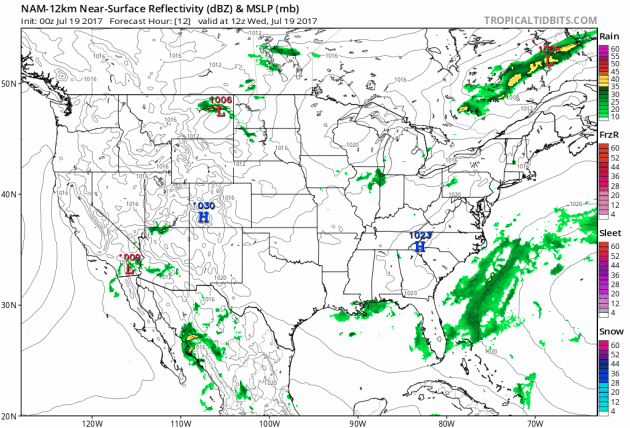
Stuck In An Overheated Rut. Severe storms rumble across the northern Plains and Upper Mississippi Valley later today, while a few airmass (instability) T-storms provide slight cooling from the Gulf Coast into the Ohio Valley. Monsoon T-storms may spark more flash flooding across Arizona and far southern California; NAM guidance hinting at a little rain for the Pacific Northwest by Friday. Future Radar: NOAA and Tropicaltidbits.com.
7-Day Rainfall Potential. Yes, that appears to be a 5″ bulls-eye over southern Minnesota and southwest Wisconsin between now and next Wednesday, and I continue to see a low-grade flash flood risk for the Upper Midwest into Saturday. A push of cooler, drier air provides temporary relief from the storms early next week, but southern Arizona may experience more flash flooding, along with Florida, the Great Lakes and Pennsylvania.
Hot Mess Into Saturday, Then Cooling Off. Models are fairly consistent pulling drier, lower-humidity air into Minnesota by Sunday and Monday with highs in the upper 70s to near 80F. More importantly: dew points are forecast to drop into the 50s, which should feel great. ECMWF numbers for the Twin Cities: WeatherBell.
Dangerous Heat Midwest to Mid Atlantic. Check out the predicted heat index Friday afternoon; as high as 110F from Des Moines and Omaha to Peoria, Louisville, Nashville, Huntsville and Macon to Raleigh and Washington D.C. Excessive Heat Warnings may have to be issued for much of the USA east of the Rockies as summer heat peaks.
Excessive Heat During Corn Pollination. Here’s an excerpt from a post at WeatherBell (paywall): “The notable exceptions are in southern Iowa and in the Dakotas. The Dakotas which have seen very dry weather and much of the corn crop is rated poor to very poor there.
Forecast for Heat
Early August: Heat Lingers Western USA. If you believe the GFS model the center of blast-furnace heat is forecast to remain over the southwestern USA into early August; very slight relief in store for the Great Lakes and New England.
Tropical Storm Don Formed and the Internet Reacted Exactly The Way You’d Imagine. Angela Fritz explains the inevitable snark at Capital Weather Gang: “On Monday night, an area of thunderstorms in the Atlantic became strong enough to be named Tropical Storm Don. The name was pulled from lists created years in advance, and any relation to any current U.S. president is purely coincidental. “Don” is no hurricane, but Twitter is having a good time with it anyways. It doesn’t help that the storm is actually pretty weak and paltry. On the other hand, a Category 5 making landfall in the U.S. wouldn’t be great for the President, either...”
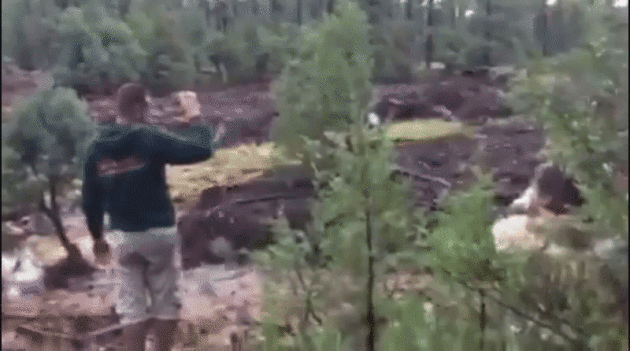
Video of Flash Flooding in Payson, Arizona. Here is some footage of the wall of water that swept down Ellison Creek, near Payson, resulting in numerous deaths and injuries nearby: “Video from Tonto Recreation Alliance signing run. Volunteers promoting responsible OHV in the Tonto National Forest...”
Witnesses Recount Horrific Flash Flood That Killed 5 Kids, 4 Adults in Arizona. It’s easy (now) to look back with 20-20 hindsight and remind readers that the NWS issued warnings in advance. But the reality is, especially when people are swimming, they don’t have access to apps on their smart phones or their AM/FM radios in their vehicles. It’s a real problem. When you’re swimming in a stream or river during the summer months situational awareness is critical, keeping an eye on what’s happening with the weather upstream. My only advice: check radar on your phone before you take that dip in your favorite creek. CBS News reports: “…The National Weather Service estimated up to 1.5 inches of rain fell over the area in an hour. The thunderstorm hit about 8 miles upstream along Ellison Creek, which quickly flooded the narrow canyon where the swimmers were. Hornung noted that the National Weather Service had issued a flash flood warning about 1 1/2 hours before, “but unless they had a weather radio out there, they wouldn’t have known about it. There is no cell phone service out here.” The swift waters gushed for about 10 minutes before receding in the narrow canyon, Hornung said. “One witness said all they heard was this tremendous roar,” Water Wheel Fire and Medical District Fire Chief Ron Sattelmaier told CBS News correspondent Mireya Villarreal...”
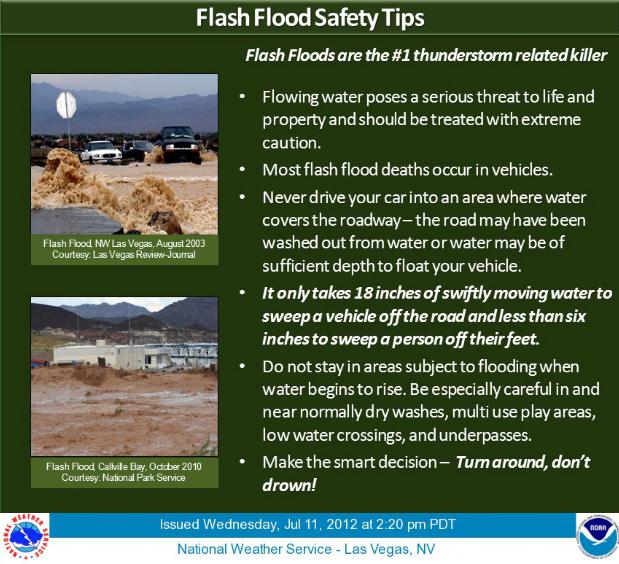
Minnesota Crop Progress and Condition. Here’s an excerpt from this week’s summary at USDA: “…Topsoil moisture supplies decreased slightly from the previous week, rating 2 percent very short, 23 percent short, 72 percent adequate and 3 percent surplus. Subsoil moisture supplies also decreased slightly, rating 1 percent very short, 14 percent short, 81 percent adequate and 4 percent surplus. Corn was 20 percent silked, a week behind last year, and five days behind the five year average. Corn crop condition rated 79 percent good to excellent. Forty-eight percent of the soybean crop was blooming, 4 days behind average, with 10 percent of soybeans setting pods. Soybean condition rated 72 percent good to excellent. Most Minnesota small grains were neary finished heading by Sunday...”
A Look Back at New England’s Worst Hurricanes, in Photos. I found a post at Boston.com to be quite fascinating: “Though hurricane season technically began June 1, the most dangerous storms to hit New England’s coast have typically arrived in late summer. Gov. Charlie Baker has officially devoted this week to hurricane preparedness, urging Massachusetts residents to educate themselves on how to prepare for a worst-case scenario weather event. Here’s a look back, in photos, at some of the worst hurricanes in local history. On Sept. 21, 1938, a record-breaking hurricane hit New England, killing 564 people and injuring 1,700 more. The Blue Hill Observatory in Milton recorded the strongest winds ever for the region, with gusts up to 186 mph, according to the Massachusetts Office of Energy and Environmental Affairs…”
File photo credit: “This September 1938 photo shows a damaged ferry boat sitting in shallow water in Providence, R.I., following the deadly hurricane of 1938 that hit the Northeast.” Leslie Jones/AP Photo.

Extreme Weather Forecasting: Looking Years, Even Decades Into The Future, Could Soon Be a Thing. My strong advice: don’t hold your breath. But in the spirit of full disclosure and getting our hopes up, here’s an excerpt of a story at news.com.au: “…Dr May’s team are now researching if the ensemble method can be used to predict weather events far into the future. By entering in variables, such as possible climate change scenarios, they can test different outcomes. “We’re making use of big data, four petabytes that’s as much as eight million laptops and we need the equivalent of 20,000 laptops joined up to generate that data,” he said. It could lead farmers to move livestock around that might be at risk, for emergency services to bolster civilian cyclone defenses or prepare for bushfires…”
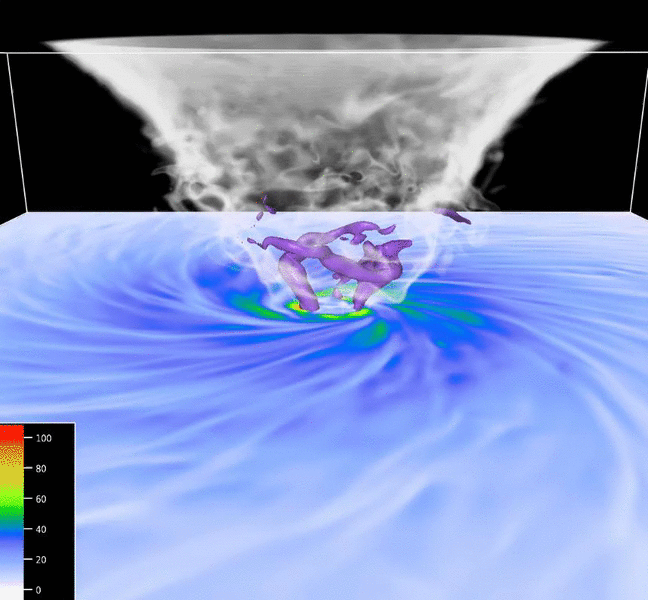
Experts Uncover the Origins of 10 Common Weather Terms. AccuWeather has an interesting post, including an explainer on how tornadoes got their name: “…Navigators exploring the tropics during the 16th century likely derived tornado from the Spanish word “tronar,” or, “to thunder,” according to linguist, teacher and author Janina Klimas. “There’s [also] a word that’s derived from that called ‘tronada,’ which is a thunderstorm,” said Klimas. “It seems that the ‘r’ and the ‘o’ got mixed up, and that’s where you get ‘tornado.’” Harper added that tornado also stems from both “tornar,” which means “to turn” in Spanish, and the Latin word “tornāre.” “At first, it was a very general word for a violent, windy thunderstorm in the tropics that gradually got the sense of turning into it, and it became our word for the funnel cloud storm,” he said…”
Tornado simulation: NCAR.
SSEC – GOES Weather App. It’s free, and it’s (very) good. Here’s some new meteorological ammunition for your favorite smartphone, in this case the iPhone or iPad: “The SSEC – GOES App brings near real-time GOES (Geostationary Operational Environmental Satellite) imagery and related data from NOAA and academic researchers to the palm of your hand. The data products are hosted by the University of Wisconsin – Madison Space Science and Engineering Center (SSEC) with visualization powered by the SSEC RealEarth™ platform.
– Includes the latest available imagery (GOES-16)
– Select products to display by category, name, and time
– Pan and zoom map interface dynamically
– Display current location on map
– Adjust transparency and composite multiple layers
– Animate by relative or absolute time steps
– Save custom favorites...”
Amazing Resolution. I took a couple of screenshots from Monday evening’s thunderstorms, the image on the right zoomed into the Twin Cities, showing individual (cumulus) cloud streets at a resolution I’ve never seen before. This is using the SSEC – GOES weather app highlighted above. Good stuff.

NMT Research Leads to New Definition of Lightning. 7 seconds? Details via dchieftain.com: “New Mexico Tech scientists have measured lightning strikes that have been declared the longest duration and the longest distance ever recorded. The new study is based on fundamental research and development by Tech professors Ron Thomas, Bill Rison, and Paul Krehbiel. Over the past 20 years, they developed the Lightning Mapping Array, or LMA, which has produced detailed records of lightning behavior. A new publication in Bulletin of the American Meteorological Society details a lightning discharge that travelled more than 200 miles in Oklahoma in 2007 and another discharge that lasted 7.75 seconds in France in 2012. Rison was credited as a co-author of the publication; all three NMT scientists were cited multiple times…”
Photo credit: “Lightning strikes inn Socorro County.” Colleen Gino for El Defensor Chieftain.
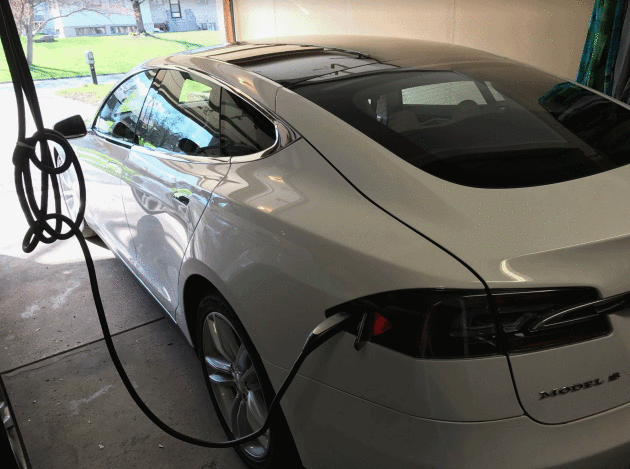
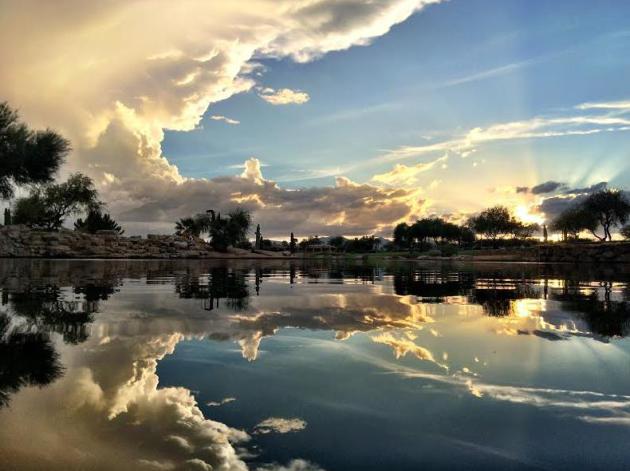
Elon Musk: “Artificial Intelligence the Greatest Risk We Face as a Civilization”. Before you laugh yourself silly keep in mind this guy has a pretty good track record predicting the future. Here’s an excerpt from Fortune: “…Musk has long been vocal about the risks of AI. But his statements before the nation’s governors were notable both for their dire severity, and his forceful call for government intervention.“AI’s a rare case where we need to be proactive in regulation, instead of reactive. Because by the time we are reactive with AI regulation, it’s too late,” he remarked. Musk then drew a contrast between AI and traditional targets for regulation, saying “AI is a fundamental risk to the existence of human civilization, in a way that car accidents, airplane crashes, faulty drugs, or bad food were not…”
Elon Musk Lays Out Worst-Case Scenario for AI Threat. The Wall Street Journal has more perspective.
Photo credit: “Elon Musk at the National Governors Association meeting in Providence, R.I., on Saturday. Mr. Musk warned about the dangers of artificial intelligence and said the high price of Tesla shares reflects optimism for the company’s future.” Photo: brian snyder/Reuters.
Globalization: The Rise and Fall of an Idea That Swept the World. Which may at least partially account for the current wave of populism, worldwide. Here’s a clip from The Guardian: “…In a panel titled Governing Globalisation, the economist Dambisa Moyo, otherwise a well-known supporter of free trade, forthrightly asked the audience to accept that “there have been significant losses” from globalisation. “It is not clear to me that we are going to be able to remedy them under the current infrastructure,” she added. Christine Lagarde, the head of the International Monetary Fund, called for a policy hitherto foreign to the World Economic Forum: “more redistribution”. After years of hedging or discounting the malign effects of free trade, it was time to face facts: globalisation caused job losses and depressed wages, and the usual Davos proposals – such as instructing affected populations to accept the new reality – weren’t going to work. Unless something changed, the political consequences were likely to get worse...”
Star Wars Lands at Disney Parks. This does look pretty cool; details via Quartz: “…Disney unveiled what it’s calling “Star Wars: Galaxy’s Edge,” the forthcoming Star Wars-themed additions to its theme parks. The new area is supposed to look like a planet in the Star Wars universe, The Verge reported, and will blend characters and objects from across the franchise’s films into a completely immersive world. There will be rides that take guests off the planet, including onto a Star Destroyer ship and a face-off against AT-ATs, and even flying on the Millennium Falcon—with all the requisite Star Wars vehicles and foes included. The world itself, from the few pictures that have been released of the massive diorama that Disney built for D23, appear to combine aspects of other Star Wars planets, including Luke Skywalker’s home world of Tatooine and the forested world of Takodana in 2015’s The Force Awakens...”
Dreaming of Alaska. I just got back from my first glimpse of Alaska. It was relentless – overwhelming; everywhere I turned there was another Eureka Moment. In addition to seeing Denali through a pall of smoke from distant wildfires, we spent some time in Fairbanks, the coldest city in the USA. You can plug in your vehicle, which makes sense considering the mercury dips below -40F at least 11-12 nights a year. Kids have outdoor recess until the air temperature goes below -20F. Now that’s hardy, and it almost makes Minnesota look like Club Med. Almost.The photo of a grizzly bear was taken on the Alaskan Highway about an hour out of Whitehorse, Yukon Territories. I was behind glass, so the bear couldn’t hear me screaming hysterically. The black wolf shot was taken in Denali National Park, which is roughly the size of Massachusetts. Staggeringly beautiful. I panned for gold in Fairbanks ($74 in gold flakes!) and witnessed one of 26 amazing glaciers in Prince William Sound. If you haven’t been to Alaska you owe it to yourself to see what is truly America’s Final Frontier. There are no words that adequately summarize how amazing this place is – it’s like an entirely different country.
Chinese Mall Introduces “Husband Storage Pods” for Shopping Wives. It’s only a matter of time before this comes to Mall of America. Here’s a clip from BBC News: “A Chinese mall has introduced “husband storage” facilities for wives to leave their spouse while they shop, it’s reported. According to The Paper, the Global Harbour mall in Shanghai has erected a number of glass pods for wives to leave any disgruntled husbands that don’t want to be dragged around the shops. Inside each individual pod is a chair, monitor, computer and gamepad, and men can sit and play retro 1990s games. Currently, the service is free, but staff told the newspaper that in future months, users will be able to scan a QR code and pay a small sum for the service using their mobile phones...”
TODAY: Murky sun, seasonably warm and sticky. Severe risk by evening. Winds: SE 7-12. High: 85
WEDNESDAY NIGHT: T-storms likely, some severe with locally heavy rain. Low: 71
THURSDAY: Becoming sunny and plenty hot. Winds: E 3-8. High: near 90
FRIDAY: More showers and heavy T-storms likely. Winds: SE 5-10. Wake-up: 72. High: 85
SATURDAY: Damp start, then partial clearing. Winds: NW 10-15. Wake-up: 71. High: 87
SUNDAY: Mix of clouds and sun, low humidity! Winds: N/NE 7-12. Wake-up: 68. High: 81
MONDAY: Plenty of sun, still comfortable. Winds: SE 7-12. Wake-up: 59. High: near 80
TUESDAY: Hazy sun, few T-storms north. Winds: SE 8-13. Wake-up: 61. High: 83
Climate Stories…
Global Warming Melts Ice, Alters Fabled Northwest Passage. Here’s a clip from AP and The Washington Post: “More than a century has passed since the first successful transit of the treacherous, ice-bound Northwest Passage by Norwegian explorer Roald Amundsen in 1906. Now The Associated Press is sending a text, video and photo team through the passage, where global warming is melting sea ice and glaciers at an historic rate, altering and opening up the Arctic in a way unprecedented in recorded history. Although the passage presents an attractive shortcut for maritime traffic between the Pacific and Atlantic oceans, only a dozen or two vessels attempt to navigate the poorly charted Canadian Arctic Archipelago during the brief summer window each year. Many are sturdy coast guard icebreakers, adventure cruises and thrill-seekers in small, nimble boats hoping to pick their way through fields of floating ice that can easily strand unprepared mariners…”
Photo credit: “Polar maritime lawyer Scott Joblin, from the Australian National University in Cambria, looks over a map aboard the Finnish icebreaker MSV Nordica as it sets sail in the North Pacific Ocean toward the Bering Strait, Thursday, July 6, 2017. A group of international researchers is sailing into the Arctic Sea aboard the Finnish icebreaker to traverse the Northwest Passage and record the environmental and social changes that are taking place in one of the most forbidding corners of the world.” (David Goldman/Associated Press).
Scientists Warn Climate Change Could Bring the Dust Bowl Back Out of the History Books. Of course land use techniques and farming practices have improved dramatically since those dark, dusty days back in the 1930s. Could it happen again? Gizmodo has details on a new study: “…In a study published on July 17 in the journal Scientific Reports, researchers at Princeton University and the National Oceanic and Atmospheric Administration’s Geophysical Fluid Dynamics Laboratory used satellite data from 2003-2015 to resolve some of the lingering uncertainty on prior dust activity models. Their research projects that “climate change will increase dust activity in the southern Great Plains from spring to fall in the late half of the twenty-first century – largely due to reduced precipitation, enhanced land surface bareness, and increased surface wind speed.” In other words, deforestation and the mega-droughts which are increasingly becoming a feature of our changing climate are likely to create conditions ideal for the return of massive dust storms...”
File photo: “A dust storm in April 1935 about to give Stratford, Texas a very bad day.” Photo Courtesy NOAA
Great Plains to See More Dust Storms in Second Half of the 21st Century. UPI has more perspective on the study referenced above: “Climate change will bring more dust storms to the Great Plains in the latter half of the 21st century, according to the latest prediction models. According to new models developed by climate scientists at Princeton University and the National Oceanic and Atmospheric Administration, already dry and dusty regions, like southwestern deserts and the central plains, will become drier and dustier in the second half of the 21st century. The increase in dry, dusty conditions in the southern parts of the Great Plains is expected to encourage an increase in the prevalence of dust storms. Global warming is expected to bring warmer temperatures to most of the globe, but the impacts of rising greenhouse gas concentrations on precipitation is more nuanced and geographically dependent. Some places are likely to experience more rain, while other places will get drier…”
File image: PBS.
Marin County, California Sues Energy Companies Over Climate Risks. The legal profession is going to log a nearly infinite number of billable hours over climate change. This will make litigation over tobacco risks look like small potatoes. Here’s an excerpt from marinij.com: “Marin County sued 37 oil, gas and coal companies Monday asserting the companies knew their fossil fuel products would cause sea level rise and coastal flooding but failed to reduce their greenhouse gas pollution. The lawsuit was part of a coordinated litigation attack by Marin, San Mateo County and the city of Imperial Beach. The Marin lawsuit, filed in Marin County Superior Court, alleges that “major corporate members of the fossil fuel industry, have known for nearly a half century that unrestricted production and use of their fossil fuel products create greenhouse gas pollution that warms the planet and changes our climate.” The suit goes on to say that even though the fossil fuel companies knew there was a narrow window to take action before consequences would be irreversible, they engaged in a “coordinated, multi-front effort” to “discredit the growing body of publicly available scientific evidence and persistently create doubt…”
Photo credit: “A display installed along the shore of Richardson Bay in Mill Valley shows sea level projections.” (Alan Dep/Marin Independent Journal).
“As the Glacier Receded, It Gave Up Their Bodies”. Yet another symptom of a warming planet. Here’s an excerpt from MSN.com: “…The regional police force told local media the bodies were discovered last week, near a ski lift on the Tsanfleuron glacier, by a worker for an adventure resort company. “The bodies were lying near each other. It was a man and a woman wearing clothing dating from the period of World War Two,” Glacier 3000 director Bernhard Tschannen told local media, according to Reuters. “They were perfectly preserved in the glacier and their belongings were intact.” Tschannen told the Tribune de Geneve that his staff believed the couple likely fell into a crevasse, “where they stayed for decades. As the glacier receded, it gave up their bodies…”
Photo credit: Associated Press.
Curbelo’s Gang of Moderate Republicans Defeats Anti-Climate Change Legislation. Grandpa, what’s a moderate Republican? Good for Rep. Curbelo – gives me renewed hope for a sane, science-centric future. Here’s a clip from Miami Herald: “Carlos Curbelo touts himself as a rare Republican in Washington willing to criticize Donald Trump and conservative members of his own party. And after months of talk and lots of tweeting, Curbelo’s effort to build a bloc of moderate Republicans capable of swaying anti-climate-change legislation appears to have paid off. Curbelo’s Climate Solutions Caucus, a group of 24 Republicans and 24 Democrats who are concerned about the impacts of climate change, voted en masse on Thursday against a proposal to nix a Defense Department report on the threats posed by climate change to military installations. “A bipartisan majority of Members are on the record saying climate change and sea level rise must be taken into account when planning for our national defense,” Curbelo said in a statement. “With military bases like Naval Air Station Key West extremely vulnerable to sea level rise, this vote was a huge win for our coastal military communities…”
In Landmark Move, GOP Congress Calls Climate Change “Direct Threat” to Security. It’s a step in the right direction, although the US Navy has been saying this for years. Here’s an excerpt from Foreign Policy: “…One study last year found that rising oceans threaten 128 military installations on the coasts, including naval facilities worth around $100 billion. The Pentagon has been aware for years of the looming danger represented by climate change. But partisan infighting in Congress, budget sequestration, and the toxic nature of the climate debate have hamstrung the Defense Dept. from taking steps to protect key assets — or even identifying which facilities face the most serious threats. This week, though, the Pentagon may have gotten a boost — from the unlikeliest of places. The Republican-controlled House retained an amendment to the 2018 defense funding bill affirming that “climate change is a direct threat to the national security of the United States.” It orders defense officials to draw up a report laying out which facilities would be most affected...”
Today’s Extreme Heat May Become the Norm Within a Decade. Here’s an excerpt from Climate Central: “…Just how soon that record heat will become the norm surprised even its researchers, but the information could be useful to officials around the world trying to plan for the changes global warming will bring to their cities and countries. It will help show when notable heat waves, downpours, or other extremes may become run-of-the-mill, and would allow planners to develop the infrastructure and policies to withstand those extremes. “At the moment, it doesn’t seem like such a big deal when we have record-hot summers or years,” study leader Sophie Lewis, a climate researcher at Australian National University, said in an email. “But this study really shows the nasty side of our current records becoming more frequent in the near future...”
Graphic credit: “Weather stations in the U.S. that are having a warmer than normal, colder than normal and record hot year.”
80% of TV Weathercasters Convinced of Human-Caused Climate Change. Here’s an excerpt of an abstract from the AMS, the American Meteorological Society: “…In contrast to prior surveys that found many weathercasters who were unconvinced of climate change, newer results show that approximately 80% of weathercasters are convinced of human-caused climate change. A majority of weathercasters now indicate that climate change has altered the weather in their media market over the past 50 years, and many feel there have also been harmful impacts to water resources, agriculture, transportation resources and human health. Nearly all (89%) believe their audience is at least slightly interested in learning about local impacts...”
The Uninhabitable Earth. This story at New York Magazine set off a furor, even among many notable climate scientists who warned against presenting an overly bleak (worst-case) scenario for fear that readers will shut down. There will be disruptions and tipping points that nobody saw coming. Here’s an excerpt: “…Until recently, permafrost was not a major concern of climate scientists, because, as the name suggests, it was soil that stayed permanently frozen. But Arctic permafrost contains 1.8 trillion tons of carbon, more than twice as much as is currently suspended in the Earth’s atmosphere. When it thaws and is released, that carbon may evaporate as methane, which is 34 times as powerful a greenhouse-gas warming blanket as carbon dioxide when judged on the timescale of a century; when judged on the timescale of two decades, it is 86 times as powerful. In other words, we have, trapped in Arctic permafrost, twice as much carbon as is currently wrecking the atmosphere of the planet, all of it scheduled to be released at a date that keeps getting moved up, partially in the form of a gas that multiplies its warming power 86 times over…”
File image: NASA.

The Power and Peril of “Climate Disaster Porn”. New Republic takes a look at the New York Magazine article referenced above, and ponders whether presenting dire worst-case possibilities is the best way to promote climate action: “…The more common critique is that Wallace-Wells engaged in some hyperbole to describe what might happen, and then didn’t present enough solutions or optimism to counter it. After spending 6,000 words on the worst-case scenario, Wallace-Wells devoted fewer than 1,000 words to possible solutions—and yet, gave credence to geoengineering, the controversial and highly unlikely idea that we deliberately manipulate the atmosphere by dumping sulfur dioxide into the the lower stratosphere to block sunlight. Wallace-Wells then described many of the scientists he interviewed as “improbably” optimistic, adding that “climate scientists have a strange kind of faith: We will find a way to forestall radical warming, they say, because we must...”
Boreal forest file photo: NASA.
Sea Level Rise Will Flood Hundreds of Cities iin the Near Future. National Geographic reports: “Sea level rise caused by global warming is usually cast as a doomsday scenario that will play out so far into the future, it’s easy to ignore. Just ask anyone in South Florida, where new construction proceeds apace. Yet already, more than 90 coastal communities in the United States are battling chronic flooding, meaning the kind of flooding that’s so unmanageable it prompts people to move away. That number is expected to roughly double to more than 170 communities in less than 20 years. Those new statistics, compiled in the first comprehensive mapping of the entire coastline of the Lower 48 states, paint a troubling picture, especially for the East and Gulf coasts, which are home to some of the nation’s most populated areas…”
Image credit: “Aerial view of sea side Miami.” Photograph by George Steinmetz, National Geographic Creative.

